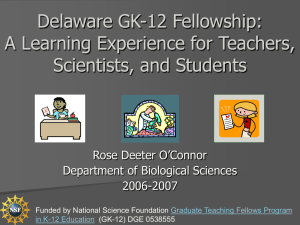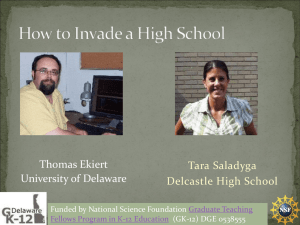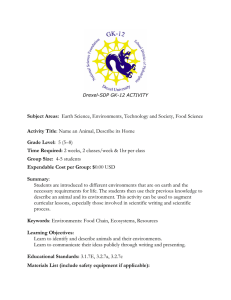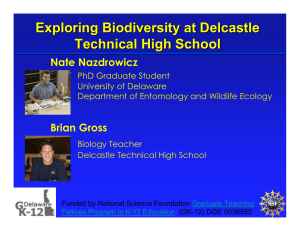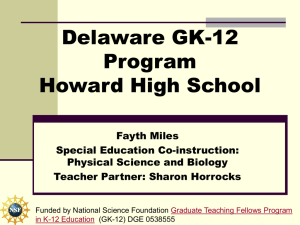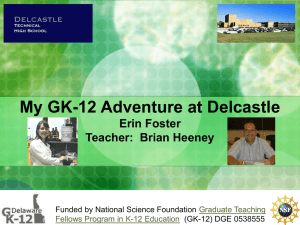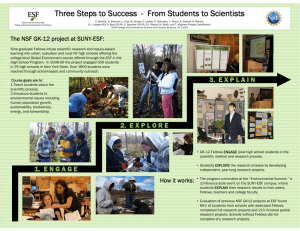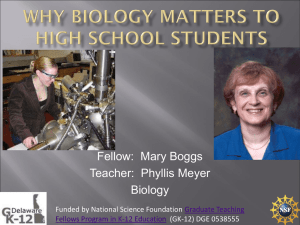UD’s GK-12 Project: Improvement of science education in vocational technical high schools
advertisement
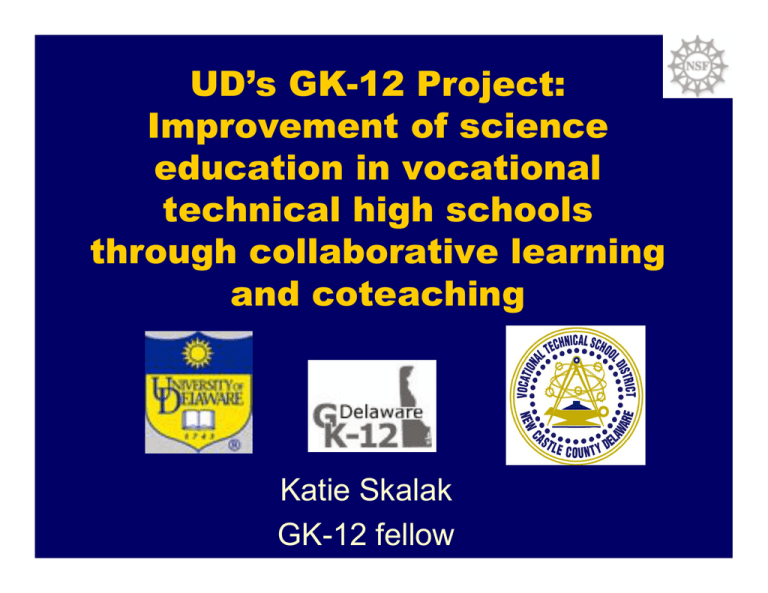
UD’s GK-12 Project: Improvement of science education in vocational technical high schools through collaborative learning and coteaching Katie Skalak GK-12 fellow GK-12 Project Leaders George Watson Kate Scantlebury Amy Quillen Physics Chemistry NCCVT Deborah Allen Biology John Madsen Richard Donham Geology MSERC, Biology 2006 GK-12 Fellows 2007 GK-12 Fellows Mary Boggs Biology John Meyer Physics Tom Ekiart Physics Nate Nazdrowicz Entymology Erin Foster Biology Chris Russell Physics Kristy Longsdorf Biochemistry Jeff Spraggins Biochemistry 2006 Teachers Dr. Ralph May Department Chair Chemistry & Integrated Science Mrs. Ingrid Anderson Biology & Physical Science Mrs. Carol Buswell Integrated Science & Physical Science Mr. Mike Kittle Biology & Physical Science Mr. Ronney Bythwood Physics & Physical Science Mrs. Sharon Horrocks Special Education Science Mr. Brian Gross Biology Mr. Brian Heeney Biology 2007 Teachers Mr. Dan Hailey Department Chair Physics & Physical Science Mr. Kevin Madigan Integrated Science& Physical Science Mrs. Elizabeth Nowak Integrated Science Ms. Tara Saladyga Physical Science Mr. Brian Gross Biology Mrs. Phyllis Meyer Biology Ms. Krista Webb Physical Science Mr. Brian Heeney Biology Purpose Through this experience, graduate students can gain a deeper understanding of their own STEM research. In addition, the GK-12 program provides institutions of higher education with an opportunity to make a permanent change in their graduate programs by incorporating GK12 like activities in the training of their STEM graduate students. Anticipated Outcomes Fellows: communication, teaching, collaboration team building skills Teachers: professional development opportunities Students: enriched learning Strengthened and sustained partnerships in STEM between institutions of higher education and local school districts. NSF GK-12 The program has been in operation for 9 years Funds approximately 600-900 fellows/year Throughout its history has worked with 1. 2. 3. more than 6,000 graduate students over 8,000 teachers and more than 550,000 students Delaware GK-12 Grant $1.7 million over three years Funding up to nine UD graduate students Paired with high school science teachers in NCCVT district To create a learning community of teaching teams to examine and reflect on current issues in education while addressing critical needs in science education in vocational technical high schools. Fast Facts about NCCVT District Number of Schools: 4 Student Enrollment: 3,386 (49% female; 39% minority) % of Special Education Students: Average Daily Attendance: Graduation Rate: 14.8% 95.3% (State = 92.6%) 96.1% * (State = 83%) All students at NCCVT take the full academic requirement needed to meet the requirements for a high school diploma. Students who meet the criteria also earn career program of study certificates. CAREER PROGRAMS OF STUDY BUSINESS, COMMUNICATION, CONSTRUCTION CLUSTER and COMPUTERS CLUSTER Electrical Trades Academy of Finance Business Software Applications Business Technology Computer Network Administration Digital Media Graphic Arts Retail Careers Technology Web and Print Technology Carpentry General Construction Heating, Ventilation, and Air Conditioning Industrial Mechanics/Millwright Technology Masonry Plumbing Sheet Metal Fabrication Welding/Fabrication Technologies CAREER PROGRAMS OF STUDY HEALTH SERVICES CLUSTER PUBLIC & CONSUMER SERVICES CLUSTER Dental Assisting Dental Lab Technology Cosmetology Emergency Medical Services Culinary Arts Medical Assisting Early Childhood Education Nursing Technology Legal Administrative Assistant Physical Therapy Services Production and Imaging Technology Practical Nursing Public Service CAREER PROGRAMS OF STUDY SCIENCE, ENERGY and DRAFTING TECHNOLOGIES CLUSTER TRANSPORTATION CLUSTER Academy of Manufacturing and Pre-Engineering Auto Technology Biotechnology Chemical Lab Technology Electronics Environmental Landscaping Technology Power Plant Technology Technical Drafting Auto Body Aviation Technology Engine Technology Career Areas at Howard High School Academy of Finance Carpentry Computer Network Administration Cosmetology Culinary Arts Dental Assistant Electrical Trades Nurse Technicians Public Service Delaware GK-12 Activities In summer workshops, teaching teams are introduced to a number of innovative teaching strategies, including problembased learning (PBL). During the academic year, Fellows engage in coteaching with their teacher partners. Fellows gain a better understanding and appreciation of the complexities and nuances of teaching science in high school. Teaching teams have the opportunity to develop PBL activities, aligned with curricular needs, for students to experience the benefits of guided-inquiry learning environments. What is Coteaching? Teaching at the elbow of the other, with multiple teachers Focus on learning of ALL students Supportive environment for analyzing and critiquing practice Opportunity to learn aspects of teaching that are not easily verbalized Link between theory and practice What are the Common Features of PBL? Learning initiated by a problem. Problems based on complex, real-world situations with no single ‘right’ answer. All information needed to solve problem is not given initially - students identify, find, and use appropriate resources. Students work in permanent groups. Students gain new information through self-directed learning. Instructors act as facilitators and designers of learning experiences and opportunities. PBL: The Process Resolution of problem; (How did we do?) Integrate new Information; Refine questions Reconvene, report on research; Research questions; summarize; analyze findings Presentation or formulation of problem Next stage of the problem Organize ideas and prior knowledge (What do we know?) Pose questions (What do we need to know?) Assign responsibility for questions; discuss resources Effective PBL Activities… Relate to real world, motivate students Require decision-making and analysis Are designed for group-solving Pose open-ended questions that encourage discussion Incorporate course content objectives Provide opportunities to develop thinking, communication, research, and other skills Connect to students’ prior knowledge and understandings (and extend them) We Use PBL to: Motivate learning by connecting science course content to real world situations Assess content understanding to inform future instruction Foster development of reasoning, communication, information retrieval, and team-building skills My role as a GK-12 fellow 2006 – coteaching with Carol Buswell in Physical Science and Integrated Science 2007 – lesson study and data collection at Howard High School Other fellows engage in coteaching at Delcastle 2006 Goals Incorporate actual research into the classroom setting Higher level transfer through problembased learning strategies Targeting these activities to the DE state standards General Activities More labs, hands-on activities, demonstrations, presentations Transfer tasks: 1. 2. 3. 4. 5. Inquiry Material Separation lab Plate tectonics Astronomy Museum exhibit Ecology: Hg contamination Journaling Newton’s 1st Law Newton’s 3rd law Comparing Energy Sources Presentations Fundamentals of geology and plate tectonics Rapa Nui as a model for resource exploitation and ecological disaster Transfer Tasks: Inquiry Goals: Devise an experiment that will test the effects of salt on temperature Write their own procedure, materials, etc. Transfer Tasks: Material Separation Student put in role of coastal geologist Must separate a “contaminated mixture” into components Student devise their own materials and methods Plate tectonics Quicktime animation with guided questions Transfer Tasks: Astronomy exhibit Goals: Understand basic astronomy principles Assessed on: ability to work in groups, understanding of principles, creativity, thoughtfulness Peer assessment Transfer tasks: Food webs and Hg cycling Scenario: Hg contamination of a recreational water source Food webs, conservation of mass, human impact, water as a resource Various roles for students to select: 1. 2. 3. 4. 5. 6. Doctor Citizen Scientist Environmentalist Industry employee Mayor Town hall meeting, concept map Hg in the environment Students are initially presented with a medical mystery Presented with Hg contamination problem, select a role Facilitated by presentations and guided research Present findings, engage in debate Lanscape concept map of water cycle, food webs, bioaccumulation, and human impact Journaling Organized, focused journaling Prompt assessment Emphasizing critical thinking and writing skills Provides students with an opportunity to reflect (self-assessment) Lesson Study Lesson study is a Japanese approach to instructional improvement. It is a cycle in which teachers work together 1. 2. 3. 4. 5. To consider their long-term goals for students, Bring those goals to life in research lessons, Conduct the lesson (with one team member teaching and others gathering evidence on student learning and development) Collaboratively observe, discuss, and refine the lessons. Teach the revised lesson in another classroom to study and improve it again. Lesson Study Steps 1. Form a lesson study group • 2. Focus the lesson study • 3. Members, schedule, ground rules Theme, subject area, unit Plan the research lesson • Long-term goals, data collection plan Teach and observe the lesson 5. Discuss and analyze the lesson 4. • 6. Focused discussion on data, revisions Reflect and plan • Re-teach the lesson Data collection Focus on the classroom as research opportunity Collect data on student understanding, misconceptions Formative assessment probes to address misconceptions Videotaping lessons, journaling, blogging, interviews Summary report to teachers Publication? Reflections on GK-12 experience Communicate science Understand how students learn Work with experienced educators Engage and motivate high school students Learn and implement effective teaching strategies Future of GK-12 1. 2. 3. 4. 5. Continued focus on graduate students with STEM research Continue regional meetings Disseminating information through partnerships and workshops (also websites). Fellows activities – integrating research into the classroom. International component to projects Acknowledgments The students The GK-12 project leaders George Watson, Kate Scantlebury, John Madsen, Deborah Allen, Richard Donham, Amy Quillen NSF for funding Howard High school teachers Carol Buswell Delcastle High school teachers 2006 and 2007 GK-12 fellows Research advisor: Jim Pizzuto
